
Shiva, also known as Mahadeva or Hara, is one of the principal deities of Hinduism. He is the Supreme Being in Shaivism, one of the major traditions within Hinduism.

The Trimurti is the trinity of supreme divinity in Hinduism, in which the cosmic functions of creation, preservation, and destruction are personified as a triad of deities. Typically, the designations are that of Brahma the creator, Vishnu the preserver, and Shiva the destroyer. The Om symbol of Hinduism is considered to have an allusion to Trimurti, where the A, U, and M phonemes of the word are considered to indicate creation, preservation and destruction, adding up to represent Brahman. The Tridevi is the trinity of goddess consorts for the Trimurti.

Ardhanarishvara, is a form of the Hindu deity Shiva combined with his consort Parvati. Ardhanarishvara is depicted as half-male and half-female, equally split down the middle.

Harihara is the dual representation of the Hindu deities Vishnu (Hari) and Shiva (Hara). Harihara is also known as Shankaranarayana.

Ishana, is a Hindu god and the dikapala of the northeast direction. He is often considered to be one of the forms of the god Shiva, and is also often counted among the eleven Rudras. He is venerated in Hinduism, some schools of Buddhism and Jainism. In the Vastu Shastra, the north-eastern corner of a plot of land is referred to as "Ishana". Ishana also shares qualities with Samhara Bhairava and is therefore a part of the Ashta Bhairava.
Matrikas (Sanskrit: मातृका (singular), IAST: mātṝkā, lit. "mothers") also called Mataras or Matri, are a group of mother goddesses who are always depicted together in Hinduism. The Matrikas are often depicted in a group of seven, the Saptamatrika(s) (Seven Mothers). However, they are also depicted as a group of eight, the Ashtamatrika(s). In the Brihat Samhita, Varahamihira says that "Matrikas are forms of Parvati taken by her with cognizance of (different major Hindu) gods corresponding to their names." They are associated with these gods as their energies (Shaktis). Brahmani emerged from Brahma, Vaishnavi from Vishnu, Maheshvari from Shiva, Indrani from Indra, Kaumari from Kartikeya, Varahi from Varaha and Chamunda from Chandi. And additionals are Narasimhi from Narasimha and Vinayaki from Ganesha.

Ravalnath, also widely known as Roulu, [a] is a popular Hindu deity in Goa and the Sindhudurg district of coastal Maharashtra, in western India. Shrines of Ravalnath are also found in border areas of Belgaum specially in Karle and Uttar Kannada districts as well as coastal areas of Karnataka. He is worshipped as the main deity or an affiliate deity in most temples of Goa. He is associated with the guardian aspect of Shiva.
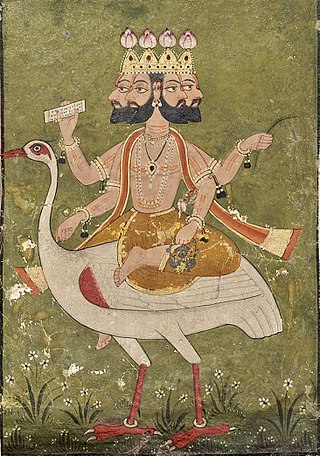
Brahma is a Hindu god, referred to as "the Creator" within the Trimurti, the trinity of supreme divinity that includes Vishnu and Shiva. He is associated with creation, knowledge, and the Vedas. Brahma is prominently mentioned in creation legends. In some Puranas, he created himself in a golden embryo known as the Hiranyagarbha.
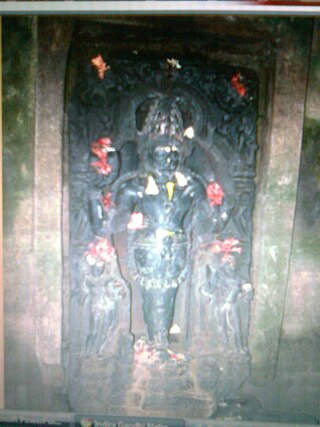
Ajaikapada Bhairava Temple is a temple dedicated to Ekapada Bhairava – an aspect of Shiva – present in Jagatsinghpur district of Odisha, India.
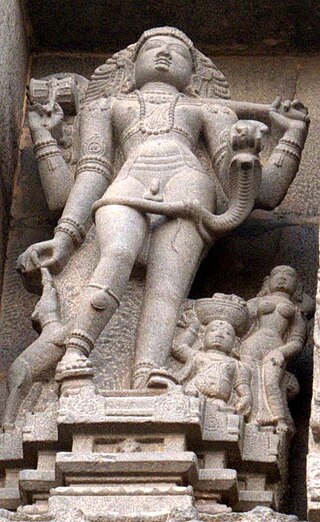
Bhikshatana or Bhikshatana-murti is an aspect of the Hindu god Shiva as the "Supreme mendicant" or the "Supreme Beggar". Bhikshtana is depicted as a nude four-armed man adorned with ornaments who holds a begging bowl in his hand and is followed by demonic attendants and love-sick women.
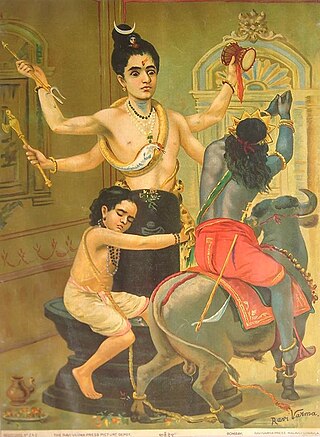
Kalantaka is an aspect of the Hindu god Shiva as the conqueror of time and death, itself personified by the god Yama. He is depicted as defeating or killing Yama when the latter comes to take the life of Shiva's devotee Markandeya. Shiva is often depicted as dancing on death, personified by Yama.

Gajasurasamhara, also Gajasamhara, Gajantaka and Gajaha and Matangari, is a fierce aspect of the Hindu god Shiva as the Destroyer of the elephant demon, Gajasura. The icon is popular in Pallava and Chola art, which portray him dancing vigorously in the flayed elephant hide of Gajasura.

Kalyanasundara, also spelt as Kalyansundar and Kalyana Sundara, and known as Kalyanasundara-murti, Vaivahika-murti and Panigrahana-murti ( पाणिंग्रहण-मूर्ति), is the iconographical depiction of the wedding of the Hindu deities Shiva and Parvati. The couple are often depicted performing the panigrahana ritual of a Hindu wedding, where the groom accepts the bride by taking her right hand in his.

Vishvarupa, also spelt as Vishwaroopa and known as Virāḍrūpa, is an iconographical form and theophany of a Hindu deity, most commonly associated with Vishnu in contemporary Hinduism. Though there are multiple Vishvarupa theophanies, the most celebrated is in the Bhagavad Gita, given by Krishna in the epic Mahabharata, which was shown to Pandava prince Arjuna on the battlefield of Kurukshetra in the war between the Pandavas and Kauravas. Vishvarupa is considered the supreme form of Vishnu, where the whole universe is described as contained within him.
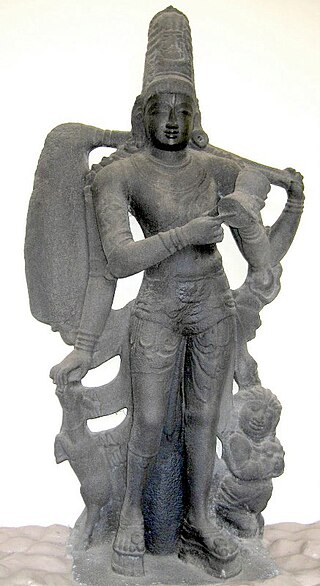
Kankalamurti, also known as Kankala ("skeleton") or Kankala-Bhairava, is an iconographical form of the Hindu god Shiva. He is often associated with a fearsome aspect of Shiva, Bhairava, and also considered to be the latter's aspect. Kankalamurti is popular in South Indian temples of Shiva, but almost unknown in North India. He is described in legends to have defeated and slain Vishnu's army-chief and gate-keeper Vishvaksena or Vishnu's avatar Vamana. He is depicted as a four-armed man with a kankala-danda (skeleton-staff) in his hand and followed by bhuta ganas and love-sick women.

Over the millennia of its development, Hinduism has adopted several iconic symbols, forming part of Hindu iconography, that are imbued with spiritual meaning based on either the scriptures or cultural traditions. The exact significance accorded to any of the icons varies with region, period and denomination of the followers. Over time some of the symbols, for instance the Swastika has come to have wider association while others like Om are recognized as unique representations of Hinduism. Other aspects of Hindu iconography are covered by the terms murti, for icons and mudra for gestures and positions of the hands and body.

Sadasiva, is the Supreme Being in the Shaiva Siddhanta tradition of Hinduism. Sadasiva is the omnipotent, subtle, luminous absolute, the highest manifestation of Shiva. Sadasiva is believed to bestow anugraha and vilaya, or grace and obscuration of pasha, which are the fourth and fifth of the Panchakritya, or the "five holy acts" of Shiva. Sadasiva is usually depicted having five faces and ten hands, and is considered one of the 25 forms of Shiva. Shiva Agamas conclude that the lingam, especially the mukhalingam, is another form of Sadasiva.
Manidvipa is the celestial abode of Mahadevi, the supreme goddess, according to the Shaktism tradition in Hinduism. It is an island situated in the middle of an ocean called the Sudha Samudra. In the Devi Bhagavata Purana, Manidvipa is portrayed as the Sarvaloka, the highest world that is superior to Goloka, the realm of Krishna and Radha, Vaikuntha, the realm of Vishnu and Lakshmi, Kailasa, the realm of Shiva and Parvati, and Brahmaloka, the realm of Brahma and Saraswati. This is consistent with the scripture's portrayal of goddess Tripura Sundari being greater than any of the Trimurti. In her form as Tripura Sundari, Devi is the ruler of Manidvipa. It is believed that Mahadevi created this island according to her will.
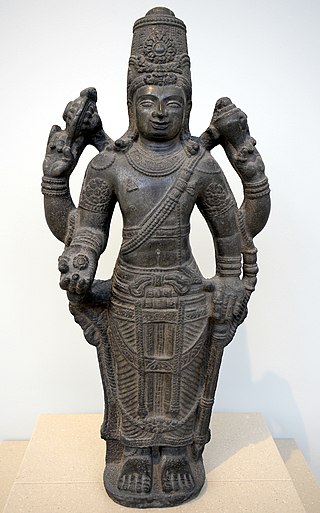
Chaturbhuja is a concept in Hindu iconography in which a deity is depicted with four arms. Several Hindu deities are often portrayed with four arms in their iconography, featured in Hindu literature. The iconography of four arms is regarded to symbolise divinity and power, as well as dominion over the four quarters of the universe.




















